Highly Hydrophobic Cotton Fabrics Modified by Poly(methylhydrogen)siloxane and Fluorinated Olefin: Characterization and Applications
Abstract
1. Introduction
2. Experimental Sections
2.1. Materials
2.2. Surface Modification of Cotton Fabrics
2.2.1. PMHS Modification
2.2.2. Fluorinated Olefin Modification
2.3. Characterization
3. Results and Discussion
3.1. Chemical Structure Analysis
3.2. Microstructure Characterization
3.3. Hydrophobicity and Water Resistance
3.4. Application in Stain-Resistance
3.5. Application in Oil–Water Separation
4. Conclusions
Supplementary Materials
Author Contributions
Acknowledgments
Conflicts of Interest
References
- Wang, L.; Xi, G.; Wan, S.; Zhao, C.; Liu, X. Asymmetrically superhydrophobic cotton fabrics fabricated by mist polymerization of lauryl methacrylate. Cellulose 2014, 21, 2983–2994. [Google Scholar] [CrossRef]
- Sasaki, K.; Tenjimbayashi, M.; Manabe, K.; Shiratori, S. Asymmetric superhydrophobic/superhydrophilic cotton fabrics designed by spraying polymer and nanoparticles. ACS Appl. Mater. Interfaces 2015, 8, 651–659. [Google Scholar] [CrossRef] [PubMed]
- Periolatto, M.; Ferrero, F.; Montarsolo, A.; Mossotti, R. Hydrorepellent finishing of cotton fabrics by chemically modified TEOS based nanosol. Cellulose 2013, 20, 355–364. [Google Scholar] [CrossRef]
- Xu, Z.; Miyazaki, K.; Hori, T. Fabrication of polydopamine-coated superhydrophobic fabrics for oil/water separation and self-cleaning. Appl. Surf. Sci. 2016, 370, 243–251. [Google Scholar] [CrossRef]
- Cao, C.; Ge, M.; Huang, J.; Li, S.; Deng, S.; Zhang, S.; Chen, Z.; Zhang, K.; Al-Deyab, S.S.; Lai, Y. Robust fluorine-free superhydrophobic PDMS–ormosil@ fabrics for highly effective self-cleaning and efficient oil–water separation. J. Mater. Chem. A 2016, 4, 12179–12187. [Google Scholar] [CrossRef]
- Huang, J.; Li, S.; Ge, M.; Wang, L.; Xing, T.; Chen, G.; Liu, X.; Al-Deyab, S.S.; Zhang, K.; Chen, T. Robust superhydrophobic TiO2@ fabrics for UV shielding, self-cleaning and oil–water separation. J. Mater. Chem. A 2015, 3, 2825–2832. [Google Scholar] [CrossRef]
- Liu, Y.; Wang, X.; Fei, B.; Hu, H.; Lai, C.; Xin, J.H. Bioinspired, Stimuli-Responsive, Multifunctional Superhydrophobic Surface with Directional Wetting, Adhesion, and Transport of Water. Adv. Funct. Mater. 2015, 25, 5047–5056. [Google Scholar] [CrossRef]
- Alammar, A.; Park, S.H.; Williams, C.J.; Derby, B.; Szekely, G. Oil-in-water separation with graphene-based nanocomposite membranes for produced water treatment. J. Membr. Sci. 2020, 603, 118007. [Google Scholar] [CrossRef]
- Li, Z.; Zhong, L.; Zhang, T.; Qiu, F.; Yue, X.; Yang, D. Sustainable, Flexible, and Superhydrophobic Functionalized Cellulose Aerogel for Selective and Versatile Oil/Water Separation. ACS Sustain. Chem. Eng. 2019, 7, 9984–9994. [Google Scholar] [CrossRef]
- Shi, G.; Shen, Y.; Mu, P.; Wang, Q.; Yang, Y.; Ma, S.; Li, J. Effective separation of surfactant-stabilized crude oil-in-water emulsions by using waste brick powder-coated membranes under corrosive conditions. Green Chem. 2020, 22, 1345–1352. [Google Scholar] [CrossRef]
- Aminayi, P.; Abidi, N. Imparting super hydro/oleophobic properties to cotton fabric by means of molecular and nanoparticles vapor deposition methods. Appl. Surf. Sci. 2013, 287, 223–231. [Google Scholar] [CrossRef]
- Li, Y.; Zou, C.; Shao, J.; Li, Y.N. Fabrication of superhydrophobic cotton fabrics through wrapping silica with plasma-induced grafting polymerization. Text. Res. J. 2019, 89, 401–410. [Google Scholar] [CrossRef]
- Xu, L.; Deng, J.; Guo, Y.; Wang, W.; Zhang, R.; Yu, J. Fabrication of super-hydrophobic cotton fabric by low-pressure plasma-enhanced chemical vapor deposition. Text. Res. J. 2019, 89, 1853–1862. [Google Scholar] [CrossRef]
- Pan, G.; Xiao, X.; Yu, N.; Ye, Z. Fabrication of superhydrophobic coatings on cotton fabric using ultrasound-assisted in-situ growth method. Prog. Org. Coat. 2018, 125, 463–471. [Google Scholar] [CrossRef]
- Yang, M.; Liu, W.; Jiang, C.; He, S.; Xie, Y.; Wang, Z. Fabrication of superhydrophobic cotton fabric with fluorinated TiO2 sol by a green and one-step sol-gel process. Carbohydr. Polym. 2018, 197, 75–82. [Google Scholar] [CrossRef] [PubMed]
- Jeyasubramanian, K.; Hikku, G.; Preethi, A.; Benitha, V.; Selvakumar, N. Fabrication of water repellent cotton fabric by coating nano particle impregnated hydrophobic additives and its characterization. J. Ind. Eng. Chem. 2016, 37, 180–189. [Google Scholar] [CrossRef]
- Mai, Z.; Shu, X.; Li, G.; Chen, D.; Liu, M.; Xu, W.; Zhang, H. One-step fabrication of flexible, durable and fluorine-free superhydrophobic cotton fabrics for efficient oil/water separation. Cellulose 2019, 26, 6349–6363. [Google Scholar] [CrossRef]
- Zhang, M.; Pang, J.; Bao, W.; Zhang, W.; Gao, H.; Wang, C.; Shi, J.; Li, J. Antimicrobial cotton textiles with robust superhydrophobicity via plasma for oily water separation. Appl. Surf. Sci. 2017, 419, 16–23. [Google Scholar] [CrossRef]
- Lei, S.; Shi, Z.; Ou, J.; Wang, F.; Xue, M.; Li, W.; Qiao, G.; Guan, X.; Zhang, J. Durable superhydrophobic cotton fabric for oil/water separation. Colloids Surf. A Physicochem. Eng. Asp. 2017, 533, 249–254. [Google Scholar] [CrossRef]
- Kong, X.; Zhu, C.; Lv, J.; Zhang, J.; Feng, J. Robust fluorine-free superhydrophobic coating on polyester fabrics by spraying commercial adhesive and hydrophobic fumed SiO2 nanoparticles. Prog. Org. Coat. 2020, 138, 105342. [Google Scholar] [CrossRef]
- Yang, J.; Pu, Y.; He, H.; Cao, R.; Miao, D.; Ning, X. Superhydrophobic cotton nonwoven fabrics through atmospheric plasma treatment for applications in self-cleaning and oil–water separation. Cellulose 2019, 26, 7507–7522. [Google Scholar] [CrossRef]
- Li, Y.; Zheng, X.; Xia, Z.; Lu, M. Synthesis of fluorinated block copolymer and superhydrophobic cotton fabrics preparation. Prog. Org. Coat. 2016, 97, 122–132. [Google Scholar] [CrossRef]
- Deng, B.; Cai, R.; Yu, Y.; Jiang, H.; Wang, C.; Li, J.; Li, L.; Yu, M.; Li, J.; Xie, L. Laundering durability of superhydrophobic cotton fabric. Adv. Mater. 2010, 22, 5473–5477. [Google Scholar] [CrossRef] [PubMed]
- Gao, Q.; Hu, J.; Li, R.; Pang, L.; Xing, Z.; Xu, L.; Wang, M.; Guo, X.; Wu, G. Preparation and characterization of superhydrophobic organic-inorganic hybrid cotton fabrics via γ-radiation-induced graft polymerization. Carbohydr. Polym. 2016, 149, 308–316. [Google Scholar] [CrossRef]
- Xi, G.; Fan, W.; Wang, L.; Liu, X.; Endo, T. Fabrication of asymmetrically superhydrophobic cotton fabrics via mist copolymerization of 2, 2, 2-trifluoroethyl methacrylate. J. Polym. Sci. Part A Polym. Chem. 2015, 53, 1862–1871. [Google Scholar] [CrossRef]
- Lee, M.; Kwak, G.; Yong, K. Wettability control of ZnO nanoparticles for universal applications. ACS Appl. Mater. Interfaces 2011, 3, 3350–3356. [Google Scholar] [CrossRef]
- Afzal, S.; Daoud, W.A.; Langford, S.J. Superhydrophobic and photocatalytic self-cleaning cotton. J. Mater. Chem. A 2014, 2, 18005–18011. [Google Scholar] [CrossRef]
- Manatunga, D.C.; de Silva, R.M.; de Silva, K.N. Double layer approach to create durable superhydrophobicity on cotton fabric using nano silica and auxiliary non fluorinated materials. Appl. Surf. Sci. 2016, 360, 777–788. [Google Scholar] [CrossRef]
- Richard, E.; Lakshmi, R.; Aruna, S.; Basu, B.J. A simple cost-effective and eco-friendly wet chemical process for the fabrication of superhydrophobic cotton fabrics. Appl. Surf. Sci. 2013, 277, 302–309. [Google Scholar] [CrossRef]
- Shi, Y.; Wang, Y.; Feng, X.; Yue, G.; Yang, W. Fabrication of superhydrophobicity on cotton fabric by sol–gel. Appl. Surf. Sci. 2012, 258, 8134–8138. [Google Scholar] [CrossRef]
- Liu, F.; Ma, M.; Zang, D.; Gao, Z.; Wang, C. Fabrication of superhydrophobic/superoleophilic cotton for application in the field of water/oil separation. Carbohydr. Polym. 2014, 103, 480–487. [Google Scholar] [CrossRef] [PubMed]
- Xu, B.; Cai, Z.; Wang, W.; Ge, F. Preparation of superhydrophobic cotton fabrics based on SiO2 nanoparticles and ZnO nanorod arrays with subsequent hydrophobic modification. Surf. Coat. Technol. 2010, 204, 1556–1561. [Google Scholar] [CrossRef]
- Xu, B.; Cai, Z. Fabrication of a superhydrophobic ZnO nanorod array film on cotton fabrics via a wet chemical route and hydrophobic modification. Appl. Surf. Sci. 2008, 254, 5899–5904. [Google Scholar] [CrossRef]
- Xu, L.; Zhuang, W.; Xu, B.; Cai, Z. Fabrication of superhydrophobic cotton fabrics by silica hydrosol and hydrophobization. Appl. Surf. Sci. 2011, 257, 5491–5498. [Google Scholar] [CrossRef]
- Zhang, M.; Zang, D.; Shi, J.; Gao, Z.; Wang, C.; Li, J. Superhydrophobic cotton textile with robust composite film and flame retardancy. RSC Adv. 2015, 5, 67780–67786. [Google Scholar] [CrossRef]
- Ivanova, N.; Zaretskaya, A. Simple treatment of cotton textile to impart high water repellent properties. Appl. Surf. Sci. 2010, 257, 1800–1803. [Google Scholar] [CrossRef]
- Wu, M.; Ma, B.; Pan, T.; Chen, S.; Sun, J. Silver-nanoparticle-colored cotton fabrics with tunable colors and durable antibacterial and self-healing superhydrophobic properties. Adv. Funct. Mater. 2016, 26, 569–576. [Google Scholar] [CrossRef]
- Pi, P.; Hou, K.; Wen, X.; Xu, S.; Cheng, J.; Xu, G.; Wang, S. A facile one-step fabrication of robust superhydrophobic/superoleophilic cotton fabric using a crosslinkable POSS-containing fluorinated copolymer. Prog. Org. Coat. 2016, 101, 522–529. [Google Scholar] [CrossRef]
- Sun, D.; Wang, W.; Yu, D. Highly hydrophobic cotton fabrics prepared with fluorine-free functionalized silsesquioxanes. Cellulose 2017, 24, 4519–4531. [Google Scholar] [CrossRef]
- Wei, C.; Tang, Y.; Zhang, G.; Zhang, Q.; Zhan, X.; Chen, F. Facile fabrication of highly omniphobic and self-cleaning surfaces based on water mediated fluorinated nanosilica aggregation. RSC Adv. 2016, 6, 74340–74348. [Google Scholar] [CrossRef]
- Meuler, A.J.; Smith, J.D.; Varanasi, K.K.; Mabry, J.M.; McKinley, G.H.; Cohen, R.E. Relationships between water wettability and ice adhesion. ACS Appl. Mater. Interfaces 2010, 2, 3100–3110. [Google Scholar] [CrossRef] [PubMed]
- Maciejewski, H.; Karasiewicz, J.; Dutkiewicz, M.; Nowicki, M. Effect of the type of fluorofunctional organosilicon compounds and the method of their application onto the surface on its hydrophobic properties. RSC Adv. 2014, 4, 52668–52675. [Google Scholar] [CrossRef]
- Li, Z.; Xing, Y.; Dai, J. Superhydrophobic surfaces prepared from water glass and non-fluorinated alkylsilane on cotton substrates. Appl. Surf. Sci. 2008, 254, 2131–2135. [Google Scholar] [CrossRef]
- Muresan, E.I.; Balan, G.; Popescu, V. Durable hydrophobic treatment of cotton fabrics with glycidyl stearate. Ind. Eng. Chem. Res. 2013, 52, 6270–6276. [Google Scholar] [CrossRef]
- Britcher, L.G.; Kehoe, D.C.; Matisons, J.G.; Swincer, A.G. Siloxane coupling agents. Macromolecules 1995, 28, 3110–3118. [Google Scholar] [CrossRef]
- Sela, Y.; Magdassi, S.; Garti, N. Newly designed polysiloxane-graft-poly (oxyethylene) copolymeric surfactants: Preparation, surface activity and emulsification properties. Colloid Polym. Sci. 1994, 272, 684–691. [Google Scholar] [CrossRef]
- Lin, W.; Huang, Y.; Li, J.; Liu, Z.; Yang, W.; Li, R.; Chen, H.; Zhang, X. Preparation of highly hydrophobic and anti-fouling wood using poly (methylhydrogen) siloxane. Cellulose 2018, 25, 7341–7353. [Google Scholar] [CrossRef]
- Liu, Z.; Yu, J.; Lin, W.; Yang, W.; Li, R.; Chen, H.; Zhang, X. Facile method for the hydrophobic modification of filter paper for applications in water-oil separation. Surf. Coat. Technol. 2018, 352, 313–319. [Google Scholar] [CrossRef]
- Nagappan, S.; Park, S.S.; Kim, B.K.; Yoo, D.; Jo, N.J.; Lee, W.K.; Ha, C.S. Synthesis and functionalisation of mesoporous materials for transparent coating and organic dye adsorption. New J. Chem. 2018, 42, 10254–10262. [Google Scholar] [CrossRef]
- Ding, Y.; Jiao, Z.S.; Guo, D.J.; Xiao, S.J.; Tan, W.; Dai, Z.D. Tunable cohesion and water lubrication of PEG-g-PMHS-c-PMVS copolymer membranes. Colloids Surf. A 2012, 395, 199–206. [Google Scholar] [CrossRef]
- Poyraz, B.; Tozluolu, A.; Candan, Z.; Demir, A.; Yavuz, M. Influence of PVA and silica on chemical, thermo-mechanical and electrical properties of Celluclast-treated nanofibrillated cellulose composites. Int. J. Biol. Macromol. 2017, 104, 384–392. [Google Scholar] [CrossRef] [PubMed]
- Ang, T.N.; Ngoh, G.C.; Chua, A.S.M.; Lee, M.G. Elucidation of the effect of ionic liquid pretreatment on rice husk via structural analyses. Biotechnol. Biofuels 2012, 5, 67. [Google Scholar] [CrossRef] [PubMed]
- Ivanova, Y.; Gerganova, T.; Dimitriev, Y.; Salvado, I.M.; Fernandes, M. Nanostructured hybrid materials as precursors for synthesis of nanocoposites in Si–O–C–N–Zr system. Thin Solid Film. 2006, 515, 271–278. [Google Scholar] [CrossRef]
- Zhang, X.; Su, W.; Lin, M.; Miao, X.; Ye, L.; Yang, W.; Jiang, B. Non-supercritical drying sol–gel preparation of superhydrophobic aerogel ORMOSIL thin films with controlled refractive index. J. Sol-Gel Sci. Technol. 2015, 74, 594–602. [Google Scholar] [CrossRef]
- Soum-Glaude, A.; Thomas, L.; Tomasella, E. Amorphous silicon carbide coatings grown by low frequency PACVD: Structural and mechanical description. Surf. Coat. Technol. 2006, 200, 6425–6429. [Google Scholar] [CrossRef]
- El Rassy, H.; Pierre, A. NMR and IR spectroscopy of silica aerogels with different hydrophobic characteristics. J. Non-Cryst. Solids 2005, 351, 1603–1610. [Google Scholar] [CrossRef]
- Han, S.W.; Park, E.J.; Jeong, M.G.; Kim, I.H.; Seo, H.O.; Kim, J.H.; Kim, K.D.; Kim, Y.D. Fabrication of recyclable superhydrophobic cotton fabrics. Appl. Surf. Sci. 2017, 400, 405–412. [Google Scholar] [CrossRef]
- Zhang, X.; Xia, B.; Ding, B.; Zhang, Y.; Luo, J.; Jiang, B. Ultra-fast surface hydrophobic modification of sol-gel silica antireflective coating with enhanced abrasion-resistance. Mater. Lett. 2013, 104, 31–33. [Google Scholar] [CrossRef]
- Gao, L.; Gan, W.; Xiao, S.; Zhan, X.; Li, J. A robust superhydrophobic antibacterial Ag–TiO2 composite film immobilized on wood substrate for photodegradation of phenol under visible-light illumination. Ceram. Int. 2016, 42, 2170–2179. [Google Scholar] [CrossRef]
- Liu, W.; Xie, T.; Qiu, R. Bamboo fibers grafted with a soybean-oil-based monomer for its unsaturated polyester composites. Cellulose 2016, 23, 2501–2513. [Google Scholar] [CrossRef]
- Zhang, X.; Lin, W.; Zheng, J.; Sun, Y.; Xia, B.; Yan, L.; Jiang, B. Insight into the organic–inorganic hybrid and microstructure tailor mechanism of sol–gel ORMOSIL antireflective coatings. J. Phys. Chem. C 2018, 122, 596–603. [Google Scholar] [CrossRef]
- Xue, C.H.; Jia, S.T.; Zhang, J.; Tian, L.Q. Superhydrophobic surfaces on cotton textiles by complex coating of silica nanoparticles and hydrophobization. Thin Solid Film. 2009, 517, 4593–4598. [Google Scholar] [CrossRef]
- Shirgholami, M.A.; Khalil-Abad, M.S.; Khajavi, R.; Yazdanshenas, M.E. Fabrication of superhydrophobic polymethylsilsesquioxane nanostructures on cotton textiles by a solution–immersion process. J. Colloid Interface Sci. 2011, 359, 530–535. [Google Scholar] [CrossRef] [PubMed]
- Lin, W.; Sun, Y.; Zheng, J.; Zheng, Y.; Yan, L.; Jiang, B.; Yang, W.; Chen, H.; Zhang, X. Surface Modification of Sol-Gel Silica Antireflective Coatings by F-PMHS: A Simple Method for Improvement of Amphiphobicity. Coatings 2018, 8, 57. [Google Scholar] [CrossRef]


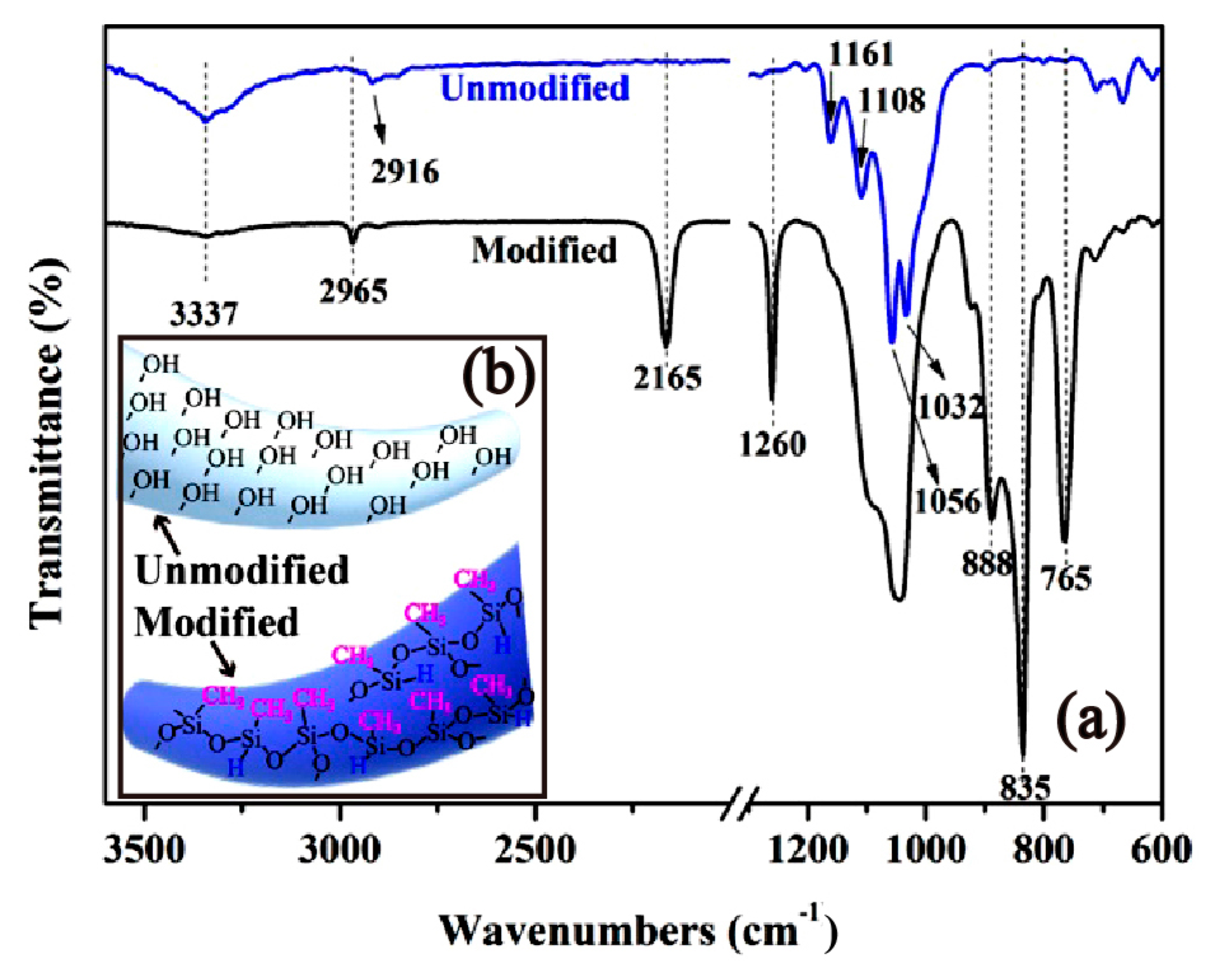
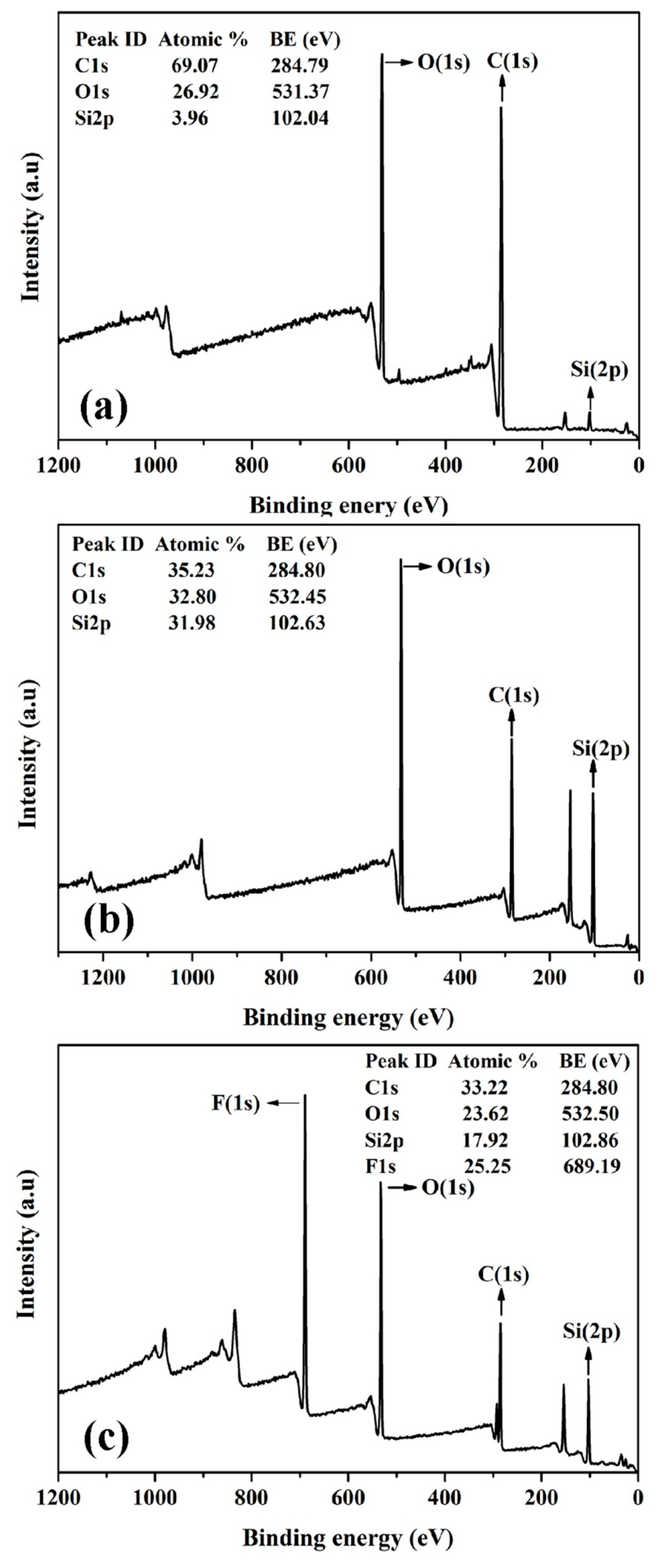
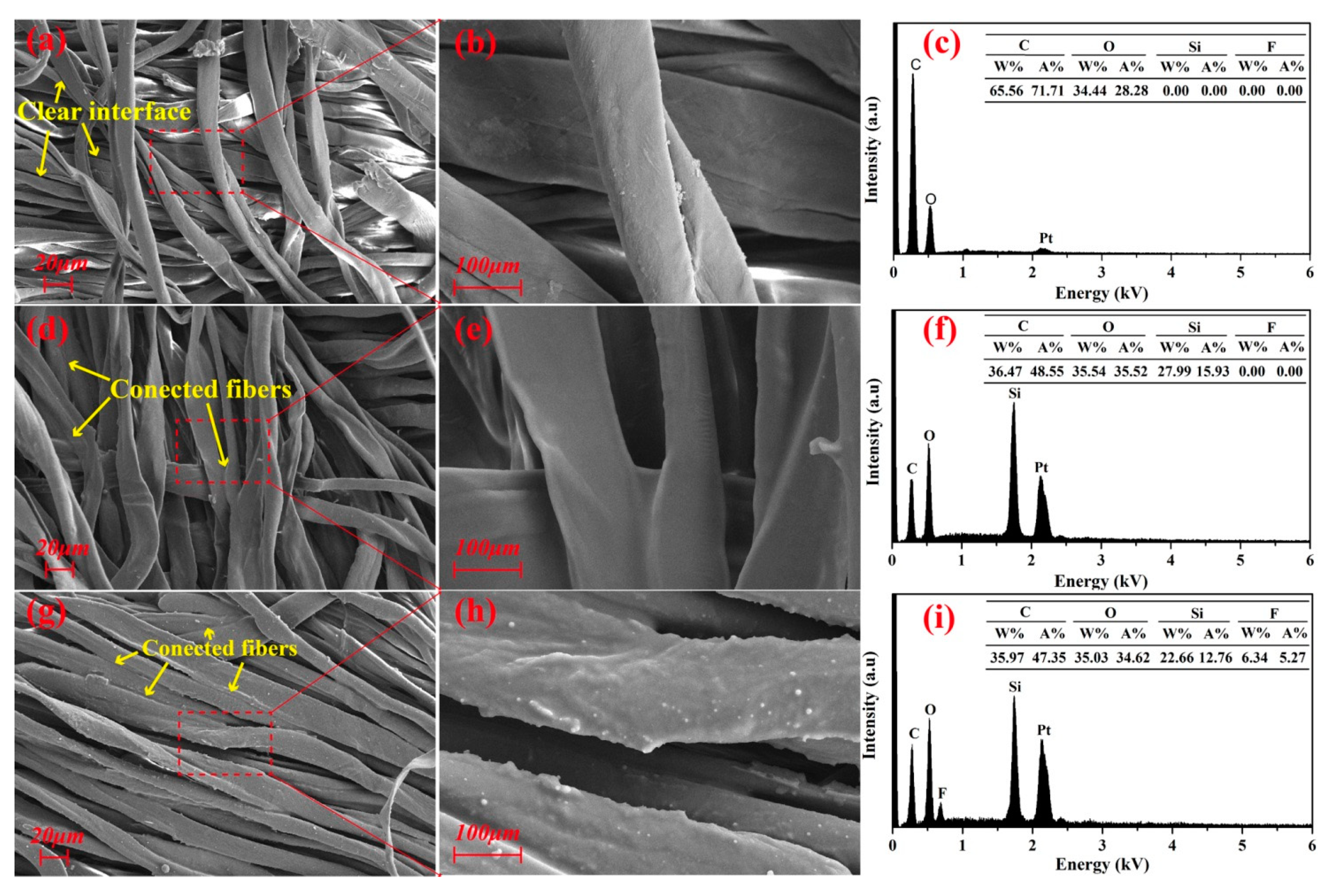
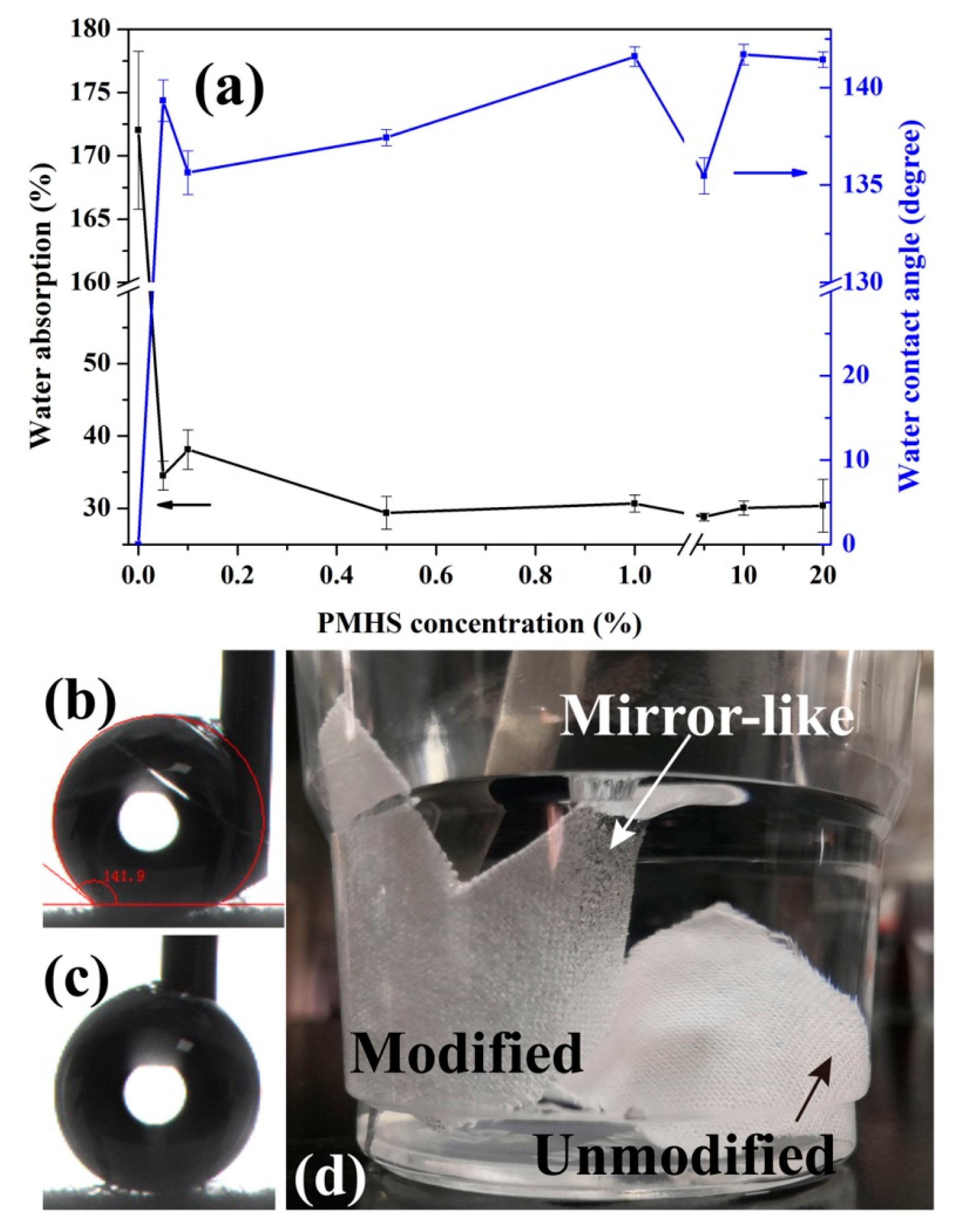
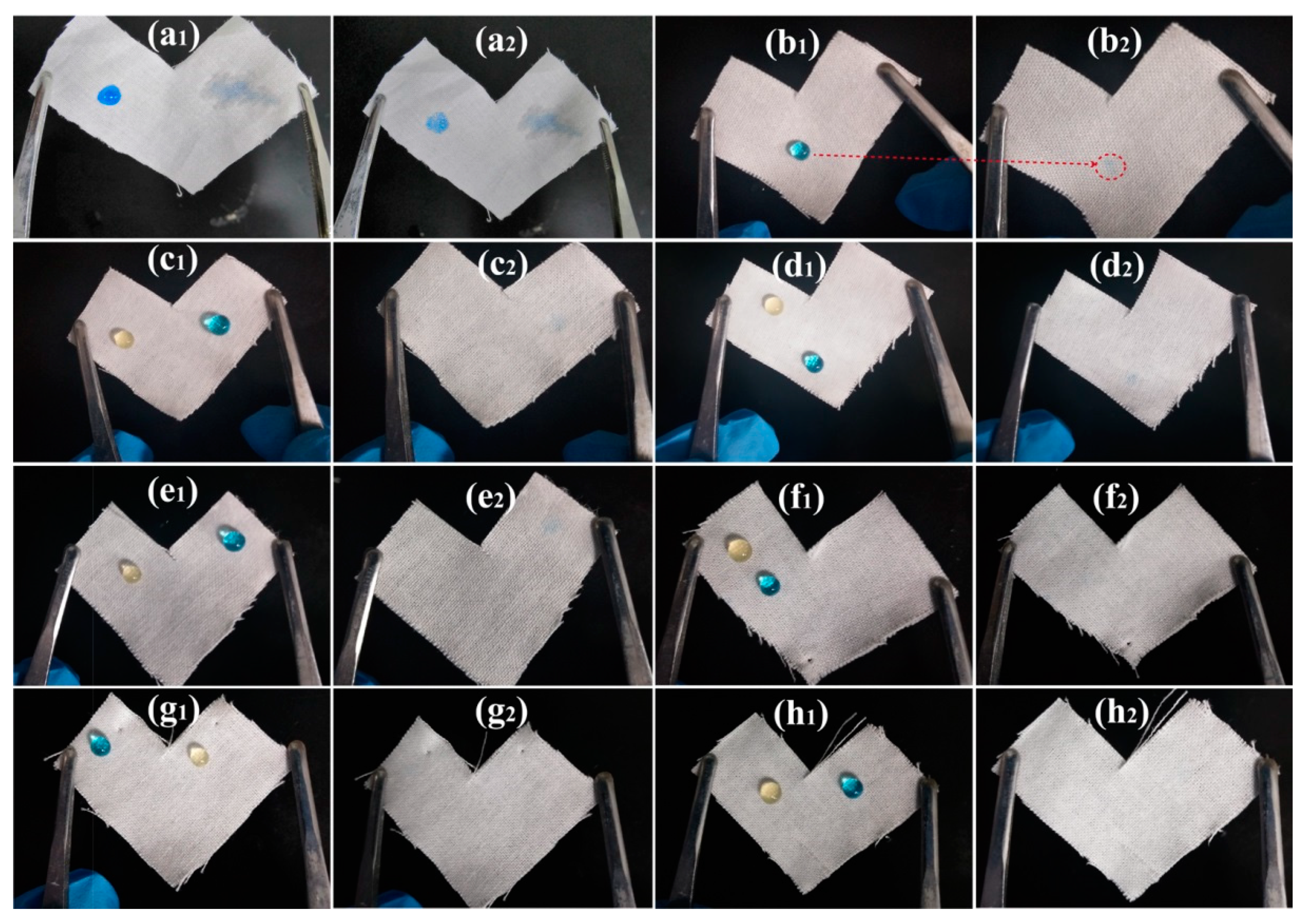

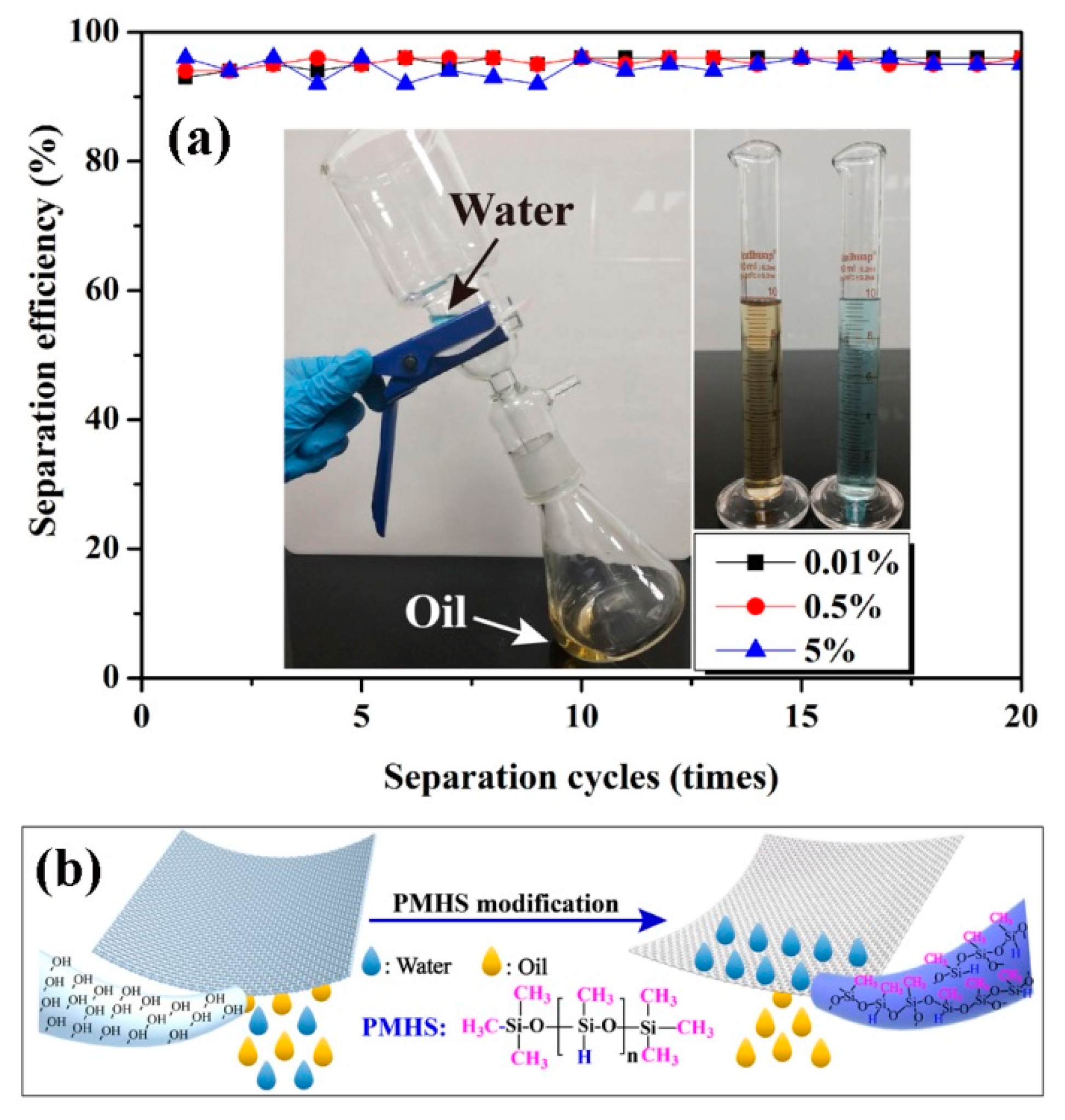
© 2020 by the authors. Licensee MDPI, Basel, Switzerland. This article is an open access article distributed under the terms and conditions of the Creative Commons Attribution (CC BY) license (http://creativecommons.org/licenses/by/4.0/).
Share and Cite
Lin, H.; Hu, Q.; Liao, T.; Zhang, X.; Yang, W.; Cai, S. Highly Hydrophobic Cotton Fabrics Modified by Poly(methylhydrogen)siloxane and Fluorinated Olefin: Characterization and Applications. Polymers 2020, 12, 833. https://doi.org/10.3390/polym12040833
Lin H, Hu Q, Liao T, Zhang X, Yang W, Cai S. Highly Hydrophobic Cotton Fabrics Modified by Poly(methylhydrogen)siloxane and Fluorinated Olefin: Characterization and Applications. Polymers. 2020; 12(4):833. https://doi.org/10.3390/polym12040833
Chicago/Turabian StyleLin, Huiping, Qingjian Hu, Tianyu Liao, Xinxiang Zhang, Wenbin Yang, and Shuang Cai. 2020. "Highly Hydrophobic Cotton Fabrics Modified by Poly(methylhydrogen)siloxane and Fluorinated Olefin: Characterization and Applications" Polymers 12, no. 4: 833. https://doi.org/10.3390/polym12040833
APA StyleLin, H., Hu, Q., Liao, T., Zhang, X., Yang, W., & Cai, S. (2020). Highly Hydrophobic Cotton Fabrics Modified by Poly(methylhydrogen)siloxane and Fluorinated Olefin: Characterization and Applications. Polymers, 12(4), 833. https://doi.org/10.3390/polym12040833





